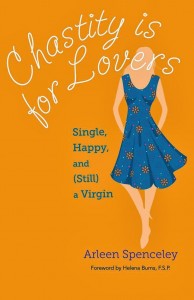Chastity and Love: Please Don’t Let Them Be Misunderstood
 Chastity and love are two of the most misunderstood concepts in our culture today. In her new book Chastity Is For Lovers: Single, Happy, and (Still) a Virgin, Arleen Spenceley does a masterful job clearing up the confusion. About chastity and how it differs from abstinence, she says:
Chastity and love are two of the most misunderstood concepts in our culture today. In her new book Chastity Is For Lovers: Single, Happy, and (Still) a Virgin, Arleen Spenceley does a masterful job clearing up the confusion. About chastity and how it differs from abstinence, she says:
Chastity neither pretends sexuality doesn’t exist nor treats it as if it is the only significant part of a person. … Chastity infuses sex with love, and love with sacrifice. Abstinence doesn’t. Chastity never trivializes sex, and it refuses to use or objectify people, It says we can have what we want when what we want is good for us and it equips us to discern whether it is.
This explanation of chastity shows how our sexuality fits into our lives. Sex outside the protective embrace of marriage is not good for us. That’s why the Church, in its wisdom, counsels against pre-marital and extra-marital sex. Sex inside marriage, when there is a grave reason to avoid pregnancy, might not be good for us either.
That’s why the Church supports periodic abstinence, or Natural Family Planning, if a married couple seriously cannot handle a child (or another child) in their relationship. Deciding whether to get married or whether to get pregnant both require discernment.
About love, Arleen says:
I wanted to get married because married people get to love. And married people do get to love. But they don’t have a monopoly on love. What I hadn’t grasped yet was that love takes multiple forms, and all of them require sacrifice.
Love is not about what you get (or what you get to do between the sheets). Love is about what you give and how you give it. Single virgins don’t get to have sex, but they also don’t have babies wanting milk from them every two to four hours day and night. It’s all a balance.
The culture tells us that love means having sex, but sex doesn’t mean having babies. Arleen explains that single people love in lots of ways that don’t include sex, and married people (in most cases) share love through having sex and having babies. Both single and married people can achieve happiness through loving and being loved.
I do disagree, however, with some advice Arleen gives on chaste dating. She insists that chaste daters need to keep the bar high, particularly with respect to virtue. She’s no longer willing “to date guys who aren’t ‘it,’ in hopes that they would grow on me.” But what she discounts is that a person might grow in virtue precisely because she demanded more of him and showed him a better way — a way to love, a way to faith, a way to God.
God’s love says we can do better and be better. But it’s the love of a good person that gives us a tangible reason to try. When I met my husband-to-be Manny, I didn’t exactly believe in chaste dating. When he told me that all he wanted was to hold hands, I felt he had rejected me so deeply that a crack fissured right through my heart. But what really broke was my hardness of heart, my misconception that my sexuality and my sexiness was my deepest value, my badly mistaken assumption that if he didn’t want sex, then he didn’t want me. He did want me, but he wanted all of me, healed by his love, healed by God’s love, forever.
So should chaste daters demand chastity from those they date? Sure. But chaste daters can teach chastity as well. God chooses the one who is “it” for us, even if they have to grow a bit to get there.

